Abel Ortiz Argumedo
De los Santos fled Yucatán, taking the contents of the state treasury with him for safekeeping and since Argumedo needed resources to buy weapons and munitions, on 26 February, in his decree núm. 3, he authorized the issue of 17 million pesos in Comisión Reguladora notes.
Peter Dunham gives a fascinating, detailed account of Argumedo’s chicanery in his article “The Early 20-Peso Notes of the Reguladora: Revolutionary Intrigues and a Major Hoard”Peter Dunham, PhD.,“The Early 20-Peso Notes of the Reguladora: Revolutionary Intrigues and a Major Hoard” in Boletín de la Socieded Numismática de México, 2010. Argumedo directed the Comisión to release the Series C and D $20 notes which had been printed along with Series A and B but not issued. Series C were placed into circulation on 26 February, the very same day as the decree, and Series D on 1 March. All were placed at the disposal of the state treasury.
By threatening not to deliver on 100,000 henequen bales already under contract to the International Harvester Company’s agent Avelino Montes, he forced Montes’ representative, Michael J. Smith, to extend him a ‘loan’ of $500,000 U.S. for the purpose of buying arms and munitions in New York. Smith provided a letter of credit for $480,000, a cheque for $19,000 and $1,000 in Mexican gold currency and in return Argumedo directed the Treasury to reimburse Montes with $3,550,000 in Series C and D notes. Between 13 and 15 March Montes provided payments of $180,000 and $24,250 US against the letter of credit but then refused to pay the balance as Carranza was already taking steps to remove Argumedo, sending one of his best general, Salvador Alvarado, to Yucatán. By 17 March Argumedo had fled, and on 19 March Alvarado assumed the governorship. On 20 March in his decree núm. 3 Alvarado nullified Argumedo’s order authorizing the C and D Series and declared the notes invalid and on 25 March in his decree núm. 7 he added that the C and D notes should be surrendered for destruction within thirty days. After that date they would be considered counterfeit and anyone possessing or using them would be liable to execution as a counterfeiter.
Montes appears to have paid $201,020 towards the 100,000 bales of henequen under contract and this amount was returned to the Comisión. On 18 or 19 March he retreated to Galveston, Texas taking the remaining $3,348,980 (167,449 notes). Ultimately the International Harvester Company purchased these notes from Montes, as a reimbursement for the payments that had been extorted from him, and the hoard, consisting of 71,964 Series C and 95,465 Series D notes, is still held by Navistar International Corporation, the present-day descendant of the International Harvester Company.

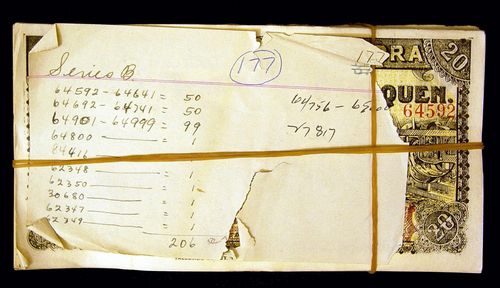

Argumedo also ransacked the local Banco Peninsular Mexicano. On 8 April its Sub-Director, A. Schmid, wrote to Carranza telling him that on 2 March Argumedo had relieved the bank of $1,100,000 in gold, whilst promising its immediate return and offering ample guarantees in henequen. When Argumedo fled he gave the bank as a guarantee $3,905,000 in Comisión Reguladora cheques, signed by Argumedo (the equivalent of 550,000 U.S.dollars) which the bank was forced to accept. Alvarado had now annulled this issue, and the bank was asking Carranza to help recover their gold and deal with the annulment. It would be more just to limit the annulment to the cheques that Argumedo had taken with him as the general annulment had devastated commerce, and the notes themselves were backed by the Comisión Reguladora's resourcesAIF, F9-69-22. However, Carranza was unsympathetic and the bank collapsed completely.
In October 1915 Carranza's government, newly recognised by the United States, pursued Argumedo in the New York court for the $900,000 that he had taken from the treasury”This is an action for an accounting and for a permanent injunction, prosecuted by the state of Yucatan against the defendant Argumedo, who for a period of five weeks and while the state of Yucatan was in a condition of revolution and anarchy acted as governor of the state, and against his depositaries.
The complaint alleges that approximately 900,000 pesos of gold Mexican currency were unlawfully removed from the treasury of the plaintiff state by the defendant Argumedo while he was acting as governor, and while he was, therefore, in the position of a trustee for the plaintiff, and under a duty to account for the safe custody of these funds. It is also alleged that Argumedo is now residing within the jurisdiction of this court, and that a portion of the moneys is within the jurisdiction, and is being unlawfully appropriated by him to his own use. The essential allegations in the complaint are sufficiently established for the purpose of this proceeding. Indeed, the defendant admits his duty and expresses his willingness to account "to the proper authorities,” but disputes the plaintiff’s right to be regarded as such, assails the right of the plaintiff to maintain the action, and urges that the court is without jurisdiction to adjudicate the issues, and further that, if it has jurisdiction, such jurisdiction should be declined
It is obvious that the commission or continuance of the alleged facts of misappropriation and misuse of the moneys belonging to the plaintiff during the pendency of the action must inevitably cause irreparable injury to the plaintiff, in violation of its rights, and, further, in view of the showing that the defendant Argumedo is not of sufficient responsibility to respond to a money judgment for anything like the amount involved, that the acts in question tend to render any judgment herein ineffectual. The principal questions, therefore, relate to the question of jurisdiction and the right and capacity of the plaintiff to maintain the action.
This action was instituted by authority of Governor Salvador Alvarado, the present Constitutionalist governor of Yucatan. The constitutional government under Carranza was established in 1914, when one Cortes, appointed governor of Yucatan by Huerta, recognized the triumph of the Constitutionalist by voluntarily offering to turn the state over to them, and did so to Major Avila, who was appointed governor by General Carranza, but was superseded on 27 January 1915, owing to suspected disloyalty, when General De los Santos was appointed governor by General Carranza. The defendant Argumedo was appointed commander of the garrison at Temax, Yucatan, by De los Santos. On 11 February 1915, the defendant and his friends drove out De los Santos, at first claiming to be an adherent of Carranza, but later, and as soon as Argumedo obtained control, he proclaimed his independence of the Carranza constitutional government in Mexico under the claim of state sovereignty for Yucatan. De los Santos with his troops joined General Salvador Alvarado, commanding the Constitutionalist army of the southeast in the neighbouring state of Campeche, who was thereupon appointed governor of Yucatan by General Carranza, and advanced to suppress the faction headed by the defendant Argumedo.
On 2 March 1915, while Merida, the capital of Yucatan, was under the military control of the defendant Argumedo, he signed as governor, and one Manuel Yrigoven Lara, whom he had appointed, signed as secretary general of the state, an order levying a forced loan of 1,100,000 pesos on the Banco Peninsular Mexicano in Merida, and this money was delivered to the treasurer general of the state and the cashier who presented the order. The money was put into the state treasury, and the defendant claimed that it was to be used for the sole purpose of purchasing arms and ammunition for the protection and defence of Yucatan and its property. It is alleged that no part of it was so used, but this is denied by the defendant. On 17 March 1915, defendant Argumedo, learning of the near approach of the Constitutionalist army under General Alvarado, left Merida, taking with him a large part of the money obtained by the forced loan from the bank, and in the latter part of the month fled from Yucatan with these moneys and went to Havana, Cuba, where he deposited a portion of the money in a safe deposit box rented in his own name at the Havana branch of the defendant Royal Bank of Canada. In April 1915, he came to New York City, and it is alleged deposited a portion of the money in a safe deposit box rented in his own name at the office of the defendant Woolworth Building Safe Deposit Company. In the meantime, and on 19 March 1915, Governor Alvarado took possession of the capital at Yucatan, restored a semblance at least of order, and guaranteed protection to all, including former refugees of the Argumedo faction. Since then he has continued in control of the government and territory, levying the regular taxes, administering the law through the courts, and carrying on the various functions of the state government. Up to date he has had no opposition of any kind, either civil or military.
Since March, 1915, the representative of the United States department of state has been instructed to take up various matters affecting the interests of American citizens in Yucatan with the officials of General Carranza as the authorities actually in control of the territory; it being understood by the state department that officials of the state of Yucatan acknowledge the superior authority of General Carranza. Governor Alvarado acknowledges and obeys General Carranza as the head of the federal government of Mexico. This action was begun on 1 October 1915. A few days later, namely, on October 19, 1915, the government of the United States extended recognition “to the de facto government of Mexico, of which-General Venustiano Carranza is the chief executive,” and the Secretary of State notified the representative of General Carranza that:
“The government of the United States will be pleased to receive formally in Washington a diplomatic representative of the de facto government as soon as It shall please General Carranza to designate and appoint such representative, and, reciprocally, the government of the United States will accredit to the de facto government a diplomatic representative as soon as the President has had opportunity to designate such representative."
If this were a controversy between two factions, each claiming to constitute the de facto government of a foreign state and in order to render an effective judgment the court had to determine which faction did constitute the de facto government, this court would naturally decline jurisdiction. Such a question is political in its nature, not judicial. But this political question has been settled, for the time being at least, and at any rate for the purposes of this litigation, by the President of the United States, who has officially recognized General Carranza as the central authority of Mexico. This recognition clearly involves the recognition by the United States of the authority of General Carranza’s governor in Yucatan.
Defendant suggests in his affidavit that the plaintiff government “is not a government by the people, and is not a government under their consent.” But “recognition is generally given by a written or oral declaration of the recognizing state; it matters little whether the recognized state co-operates in it or not.” It is enough that it is now the recognized sovereign ; the action by the chief executive of the United States government conclusively binding this court and all courts in this country. This deprives of any weight whatsoever defendant’s contention that his accounting, which, he admits he is obligated to make “to the proper authorities,” should be postponed until “a stable form of government is established.” In view of the action of our government, it is merely incumbent upon this court to find that the authorities who- directed the bringing of this suit are “the proper authorities” and that they in fact constitute “a stable form of government.” Recognition is never accorded until, in the opinion of the executive, the government recognized is stable, and on this political question the opinion of the executive, whether right or wrong, is the only opinion that can be considered.
It makes no difference that the recognition followed by a few days the institution of this action, for the recognition of the Carranza government relates back to its inception, and all acts of the plaintiff government of Yucatan, such as the bringing of this action, are ratified. The plaintiff, as the recognized state government, is vested with all state property, including title to the state funds accumulated during previous de facto regimes and to the cause of action which accrued to the state when its funds were misappropriated. Practically all of the cases on the right of a state to sue proceed upon the theory that the state is continuous and the right of action really resides in the aggregate body of the people who are merely represented by particular governmental organizations which may change in character or personnel. When a de facto government is recognized and becomes the de jure government, the recognition relates back to the inception of the government, and it thereupon becomes lawful from the beginning.
It is claimed that the plaintiff has not capacity to sue, and that the action should be brought by the ambassador of the republic of Mexico, when appointed, in plaintiff’s behalf. It was early settled in this state that a foreign government may maintain an action in the New York state courts in the name of the state as an aggregate body. The court said:
“In my opinion, the action can be maintained in the name of the republic as an aggregate body; and the modes of proceeding in cases of foreign corporations, and of other states of the Union may be resorted to for the regulations of the practice.”
The only real question as to jurisdiction, is whether the court should decline jurisdiction and relegate the parties to the courts of Yucatan, because the questions on the accounting, involving the lawfulness of defendant’s expenditures, so peculiarly concern the internal and governmental affairs of Yucatan.
Defendant also claims that, having been governor for five weeks, his acts while governor are subject only to the congress of Yucatan and that he must be proceeded against by a court of impeachment. There is nothing in this, however, for the action taken by the United States government establishes for the purpose of this action that he was not the governor, but merely an interloper and usurper. In determinating whether to decline jurisdiction, the court cannot ignore the admitted fact that the defendant does not intend to return to Yucatan, at any rate as long as General Carranza remains supreme, for he states that he would be executed. To decline jurisdiction would leave the state of Yucatan absolutely without remedy. Most assuredly there are special circumstances in the case at bar requiring the court to retain jurisdiction. Any other rule would make this state the haven of absconders.
Motion to continue the injunction pendente lite granted, with $10 costs. (State of Yucatan v. Argumedo, 157 N.Y.S. 219, 227 (N.Y. Sup. Ct. 1915)).
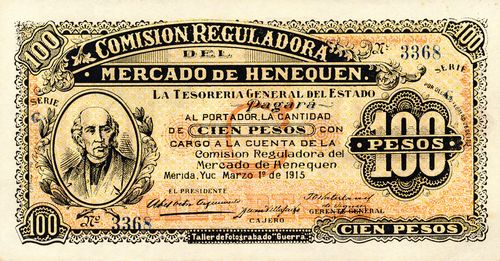
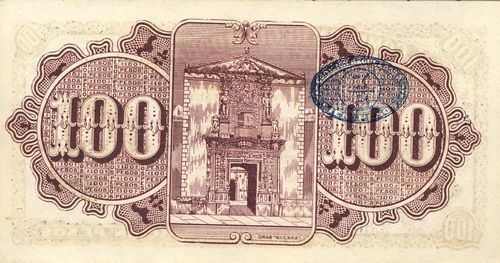 M4160 $100 Comisión Reguladora
M4160 $100 Comisión Reguladora
The $100 notes consequent to Argumedo’s decree of 26 February are dated 1 March 1915 and carry the signatures of Argumedo as president, Juan Villafaña as cashier (cajero) and T. O. Waterland de Vignier as general manager.
|
Abel Ortiz Argumedo was born in Ixmiquilpan, Hidalgo in 1871. After serving as a coronel for Carranza, in 1914 he offered his services to governor Eleuterio Avila and was named comandante militar of Mérida. Afer Carranza replaced Avila with Toribio de los Santos Argumedo seized power and declared himself governor on 12 February 1915. He tried to justify his actions to Carranza but the latter sent Salvador Alvarado against him. Alvardo’s troops defeated Argumedo's in Campeche and Yucatán and he entered the capital in triumph on 19 March. Argumedo fled to Havana, Cuba with most of the state’s treasury. Much later he returned to Mexico City, where he died in 1962, at 90 years of age. |
 |
| [if correct person] In June 1913 Juan Villafaña Ojeda was appointed gerente of the newly formed Empresa Editora Yucateca, S. A., the producers of La Revista PeninsularPeriódico Oficial, 10 June 1913. |
 |
|
In 1924 he was in charge of the Sección de Estadista de la Tesorería General del EstadoPeriódico Oficial, 19 May 1924. He died in Mérida in May 1929, at the age of 82Periódico Oficial, 31 May 1929. |
 |
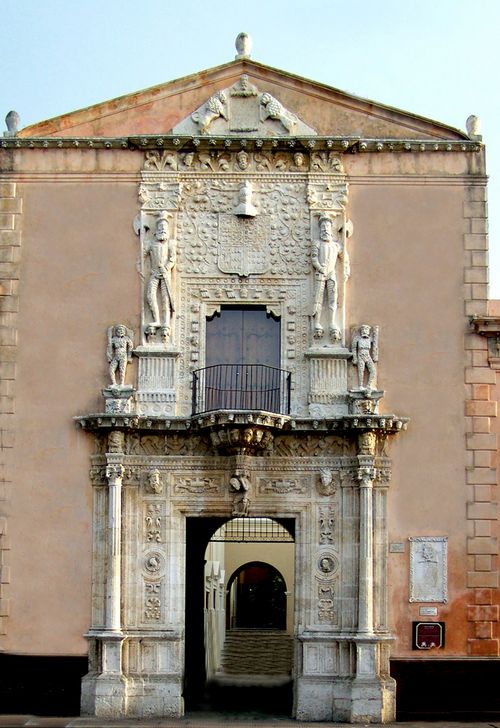
The vignette is of the front of the Casa de Montejo on the south side of the Plaza Grande in Merida. This building was constructed between 1542 and 1549 by the Spaniards who conquered the Yucatán, Francisco de Montejo and his relatives, as a family residence. On the façade the conquistadors with halberds are standing on the heads of defeated Indians. The mansion served members of the Montejo family until 1970: today it is owned by the Fomento Cultural Banamex and houses a museum.
The $100 notes will also have had a short circulation life. The $50 notes do not seem to have been printed.
To summarise:
| date of issue | Series | from | to | total number |
total value |
||
| $20 | 26 February 1915 | C | 0001 | 100000 | 100,000 | $ 2,000,000 | includes numbers 6656CNBanxico #12400 to 79820CNBanxico #6550 |
| 1 March 1915 | D | 0001 | 100000 | 100,000 | 2,000,000 | ||
| $100 | A | includes numbers 0705CNBanxico #12402 to 2168 | |||||
| B | includes numbers 1474 to 6185CNBanxico #12403 | ||||||
| G | includes numbers 1507CNBanxico #6552 to 3363 | ||||||
| H |
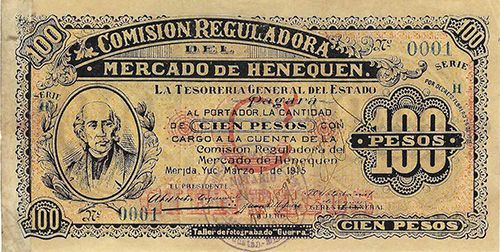
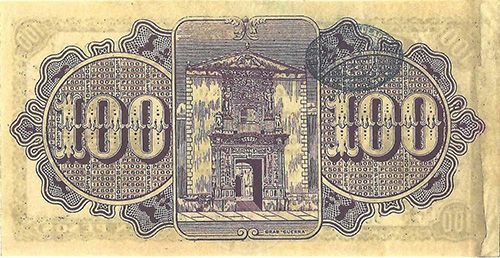
M4160 $100 H 0001 notarised for the document recording the issue of this series

 Thomas Oliver Dunne Waterland de Vignier was born in 1848.
Thomas Oliver Dunne Waterland de Vignier was born in 1848.